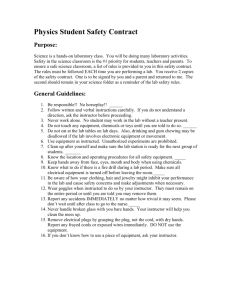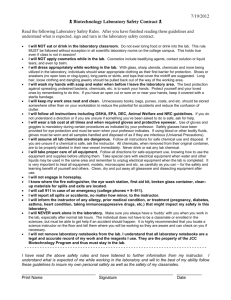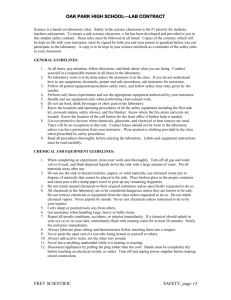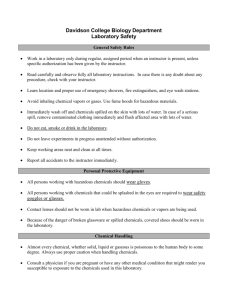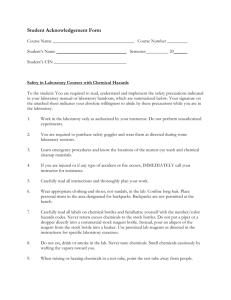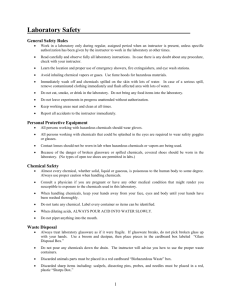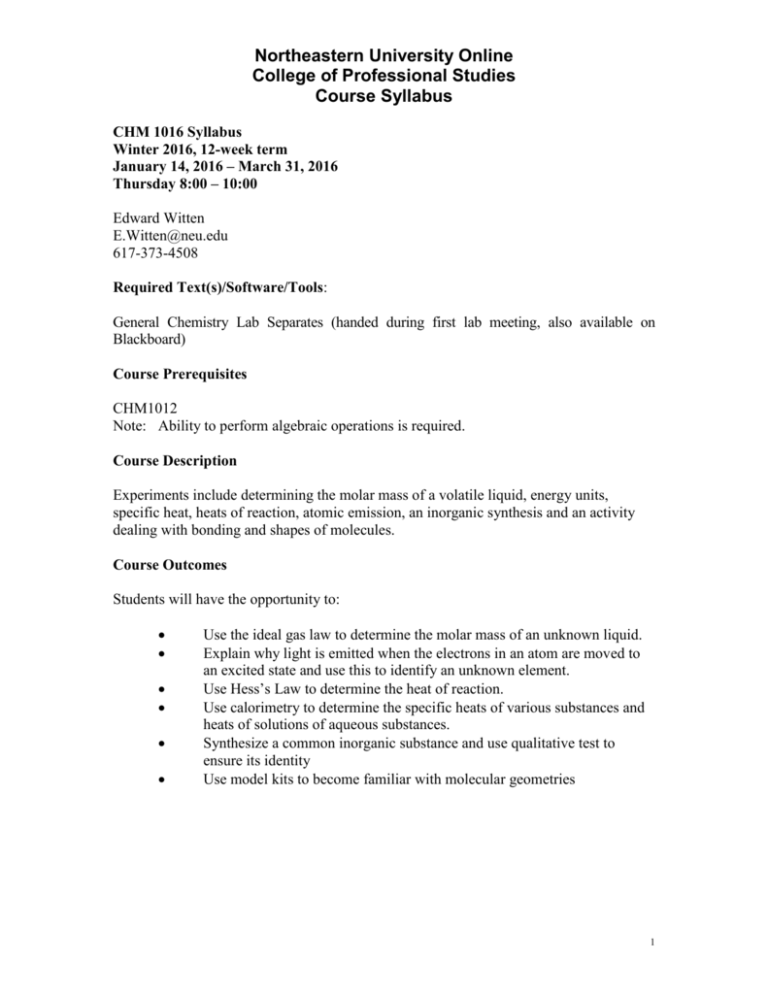
Northeastern University Online
College of Professional Studies
Course Syllabus
CHM 1016 Syllabus
Winter 2016, 12-week term
January 14, 2016 – March 31, 2016
Thursday 8:00 – 10:00
Edward Witten
E.Witten@neu.edu
617-373-4508
Required Text(s)/Software/Tools:
General Chemistry Lab Separates (handed during first lab meeting, also available on
Blackboard)
Course Prerequisites
CHM1012
Note: Ability to perform algebraic operations is required.
Course Description
Experiments include determining the molar mass of a volatile liquid, energy units,
specific heat, heats of reaction, atomic emission, an inorganic synthesis and an activity
dealing with bonding and shapes of molecules.
Course Outcomes
Students will have the opportunity to:
Use the ideal gas law to determine the molar mass of an unknown liquid.
Explain why light is emitted when the electrons in an atom are moved to
an excited state and use this to identify an unknown element.
Use Hess’s Law to determine the heat of reaction.
Use calorimetry to determine the specific heats of various substances and
heats of solutions of aqueous substances.
Synthesize a common inorganic substance and use qualitative test to
ensure its identity
Use model kits to become familiar with molecular geometries
1
Course Methodology
Each week, you will be expected to:
1.
2.
3.
4.
Review the week's learning objectives.
Complete all assigned readings.
Complete and submit all assignments by due dates.
Attend class each week.
Grading/Evaluation Standards
Prelab Questions
Lab Reports Sheets
Post Lab Questions
10%
50%
40%
Assignment of Letter
Due dates for lab reports will be determined
by your instructor.
Grades
> 450 pts
A
> 400 pts
B
> 350 pts
C
> 300 pts
D
< 300 pts
F
Purpose
Practice in the application of basic chemical principles is an important part of the course,
and is carefully integrated with the lecture material. The laboratory is the place where the
abstract lecture topics come to life before your eyes! You should study and understand each
experiment before coming to the laboratory. See your lab instructor before your lab if you
have any questions. Feel free to consult reference materials in the Snell Library. If you
prepare for lab, you will find your experience more informative and enjoyable.
COURSE STRUCTURE
1.
Check-list: The following is a check-list of the things you will need for the FIRST
lab meeting
A. EYE PROTECTION - Government regulations insist that all persons
present in the laboratory must wear some sort of eye protection, whether or not the person is
him/herself working on an experiment. If you do not wear shatterproof prescription glasses,
you must purchase protective eye-wear at the University Bookstore before coming to the
lab.
2
FAILURE TO WEAR APPROPRIATE EYE PROTECTION AT ALL TIMES IN
THE LABORATORY IS GROUNDS FOR DISMISSAL FROM THIS COURSE.
Contact lenses maybe worn in the laboratory. However, you still must wear some
form of eye protection.
B. Laboratory Handbook for General Chemistry (Optional) - Get a copy at the
Bookstore before your first lab meeting. This book describes how to correctly perform many
techniques needed in general chemistry. When applicable assignments will be listed on the
last page of this handout.
2.
Grading of Experiments: The basis is 100 points per experiment (90 points for your
lab report and 10 points for the answers to the prelab questions. The lowest
experiment grade will be dropped. If you miss one laboratory period, this will count
as your dropped grade; additional missed labs will count as ZERO. If you miss a lab
you can make it up during a scheduled make-up lab week. Chemical responsibility
and safety will count for at least 10% of your lab grade.
3.
CHEMICAL RESPONSIBILITY
It is important for every student to have a basic understanding of the dangers
and hazards associated with thoughtless disposal of chemicals. We no longer live in
an age of a "throw away society". It is our duty to protect the environment by
disposing of toxic and hazardous chemicals properly. You will be clearly advised in
each experiment, by way of a handout sheet, the dangers of each chemical to be used
during that day's experiment and the proper method for disposal. Some chemicals
may be perfectly safe to dispose of down the drain, while others will be placed in
waste disposal bottle. Make sure you follow these instructions. If you are not sure
of what to do with your waste chemicals, check with your lab instructor and be
sure they go into the proper bottle, appropriately labeled. The hoods will often
contain bottles for several experiments. It is also possible, that your experiment may
require more than one waste bottle. Again, read the label and dispose of your
chemical waste into the proper bottle. Post-lab questions are likely to ask about
chemical responsibility.
Two chemicals that need specific mention are mercury and acetone. The general
chemistry labs should have no mercury present. If you happen to have a mercury
thermometer, bring it to the stockroom to be replaced by an alcohol filed
thermometer. A mercury thermometer has a silver liquid in the bulb, an alcohol
thermometer is filled with a red colored liquid. No acetone or mercury should be
poured into the drains in this building. The small amount of acetone to be used in
this course should be placed in its appropriate waste container. The state of
Massachusetts monitors the level of these chemicals leaving the building and can
determine if students are not complying with proper waste procedures. If you are
going to be taking organic chemistry in the future this warning will be even more
important in these courses.
3
4.
Lab Reports are due the week following the period in which the experiment was
performed or when specified by your lab instructor. All calculations should also be
included in your report (they should be neat and legible). Lab reports for
experiments that involve unknowns will be graded on how close your experimental
value is to the actual value and on how reproducible your results are. Before
disassembling your apparatus for the week, check with your instructor to make sure
you have carried out the required work and that you have collected the data needed
to prepare your lab report. If there is a problem with your data, your instructor
should inform you to perform additional measurements in order to ensure a good
grade. You will lose points on your lab reports, if you do not follow the directions in
the experiments for example, if it tells you to perform two experimental
determinations of your boiling point and they should be within a certain temperature
range of each other, if your values are not within the specified range you will lose
some credit). The format of the lab report is as follows:
A.
Introduction - This should be brief (one or two sentences) and should
include the objective of the week’s experiment.
B.
Chemical Responsibility - This section should include dangers and
hazards associated with that weeks lab and the proper disposal of all
chemicals from that week’s experiment.
C.
Report sheet - The report sheet from the lab separates, with all
pertinent information included.
D.
Sample Calculations - These can be put on the tear-out sheet or on a
separate piece of paper, but it should be written neatly.
E.
Answers to supplemental questions.
F.
Conclusions - This should be brief (one or two sentences) and it
should summarize any conclusions you have made about the experiment.
5.
Your lab instructor will give a brief pre-lab talk each week. You will not be allowed
to start that day's experiment until the pre-lab talk is finished.
6.
Chemicals: All chemicals should be handled with caution. If you get any chemical
on yourself, wash the affected area with plenty of soap and water. Disposable gloves
are available in your lab room.
Report all chemical spills to your lab instructor.
Chemicals should be kept where they are found. You should take only what you
need and close and tightly cap the container. Clean-up any material spilled at once
(check with your instructor for proper clean-up instructions). Do not remove any
chemicals from the laboratory.
4
7.
Clean up: You are responsible for cleaning up your work area after each lab. You
should wash your hands with soap and water after finishing your experiment each
week. Hand soap is available in the lab.
8.
Clothing: You should wear clothes that cover the maximum amount of the body.
Shorts and sandals are not recommended for lab.
9.
Glassware: Clean all glassware before leaving the lab for the day.
10.
11.
Disposal: Dispose of all chemicals as outlined on the chemical responsibility sheet.
GIVE A HOOT, DON'T POLLUTE.
Lab Cancellation Policy: In the event your lab section is canceled due to weather
conditions, you will perform the missed experiment the following week, and will
continue with the schedule in order as listed on the last page of this handout.
12.
Accidents: Report any accident to your lab instructor.
13.
The Lab Schedule will follow the schedule below.
14.
Office Hours: Your lecturer will be available to help you by special arrangements. I
will also answer questions by email.
15.
Withdrawal:
To withdraw from the course, you must officially withdraw.
Absence does not guarantee automatic withdrawal. Any student who does not
formally withdraw and has an unexcused absence for the final exam will receive an
F. Grades of W must be converted to passing letter grades before a student may
enroll in Chemical Principles III (CHM2021). When repeating the course, no grades
are carried over from exams or quizzes that a student may have taken before
withdrawing from the course the first time.
16.
Incomplete:
To get an incomplete (I) grade, you must have a passing
grade for the work already done. An incomplete will not be given for work missed
because of unexcused absences. To have an excused absence, you must have a
medical reason documented by the Northeastern Health Service or a doctor, or you
must present an acceptable reason in writing to your lecturer instructor. Unless you
choose to remove the incomplete by repeating (and paying a second time for) the
entire course, only the missing exam, etc, may be made up. Grades of I must be
converted to passing letter grades before you may enroll in Chemical Principles III
(CHM2021).
17.
Missed Work: You are responsible for all announcements and requirements even if
you were absent when they were made. If you miss all or part of any class, check
with a classmate to find out what you have missed.
5
18.
Registration: Your name must be on the official Registrar's list for this course in
order to receive a grade. If your name is not on this list, fill out a form and turn it
into your instructor.
Class Schedule / Topical Outline
Week
Date
1
1/14
Safety Lecture
Check In
1/21
Answer Prelab Questions for
Molecular Weight of a Volatile
Molecular Weight of Volatile
Liquid
Liquid Experiment
2
3
4
5
1/28
2/4
2/11
Lab Experiment
Units of Energy
Specific Heat
Turn In Lab Report for Units
of Energies
Read Specific Heat and
Answer Pre-Lab Questions
Heat of Reaction
Turn in Lab Report for Heat
of Reaction
Read Atomic Emission and
Answer Pre-Lab Questions
2/18
Atomic Emission
7
2/25
Make Up Night
3/3
Turn in Molecular Wt
Experiment Lab Report
Read Units of Energy and
Answer Pre Lab Questions
Turn in Lab Report for
Specific Heat
Read Heat of Reaction and
Answer Pre-Lab Questions
6
8
Assignments
Molecular Geometries
Turn in Lab Report for
Atomic Emission
Read Molecular Geometries
and Answer Pre-Lab
Questions
Turn in Lab Report for
Inorganic Synthesis: Preparation
Molecular Geometries
of Sodium Thiosulfate
Read Inorganic Synthesis and
Pentahydrate
Answer Pre-Lab Questions
9
3/10
10
3/17
TBA
11
3/24
Make Up Night
12
3/31
No Lab Final Exam Night
Turn in Lab Report for
Inorganic Synthesis
6
Academic Honesty and Integrity Statement
The University views academic dishonesty as one of the most serious offenses that a student can
commit while in college and imposes appropriate punitive sanctions on violators. Here are some
examples of academic dishonesty. While this is not an all-inclusive list, we hope this will help
you to understand some of the things instructors look for. The following is excerpted from the
University’s policy on academic honesty and integrity; the complete policy is available at
http://www.cps.neu.edu/about-cps/policies-and-procedures.
Cheating – intentionally using or attempting to use unauthorized materials, information or study
aids in an academic exercise. This may include use of unauthorized aids (notes, texts) or copying
from another student’s exam, paper, computer disk, etc.
Fabrication – intentional and unauthorized falsification, misrepresentation, or invention of
any data, or citation in an academic exercise. Examples may include making up data for a
research paper, altering the results of a lab experiment or survey, listing a citation for a source
not used, or stating an opinion as a scientifically proven fact.
Plagiarism – intentionally representing the words or ideas of another as one’s own in any
academic exercise without providing proper documentation by source by way of a footnote,
endnote or intertextual note.
Unauthorized collaboration – Students, each claiming sole authorship, submit separate
reports, which are substantially similar to one another. While several students may have the
same source material, the analysis, interpretation and reporting of the data must be each
individual’s.
Participation in academically dishonest activities – Examples include stealing an exam, using
a pre-written paper through mail order or other services, selling, loaning or otherwise
distributing materials for the purpose of cheating, plagiarism, or other academically dishonest
acts; alternation, theft, forgery, or destruction of the academic work of others.
Facilitating academic dishonesty – Examples may include inaccurately listing someone as
co-author of paper who did not contribute, sharing a take home exam, taking an exam or
writing a paper for another student.
Northeastern University Online Policies and Procedures
For comprehensive information please go to http://www.cps.neu.edu/online/
Northeastern University Online Copyright Statement
Northeastern University Online is a registered trademark of Northeastern University.
All other brand and product names are trademarks or registered trademarks of their respective
companies.
This course material is copyrighted and all rights are reserved by Northeastern University Online.
No part of this publication may be reproduced, transmitted, transcribed, stored in a retrieval
system, or translated into any language or computer language, in any form or by any means,
electronic, mechanical, magnetic, optical, chemical, manual, or otherwise, without the express
prior written permission of Northeastern University Online.
Copyright 2011 © by Northeastern University Online
All Rights Reserved
7


